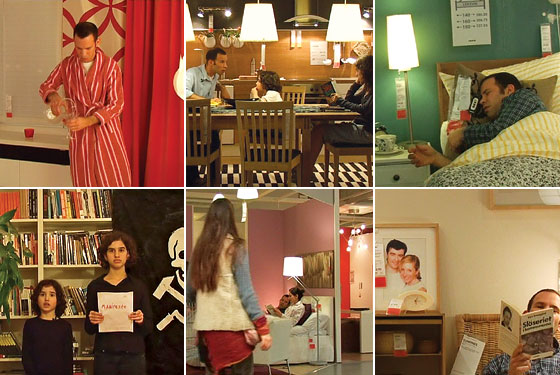 |
Guy Ben-Ner's family, as depicted in Stealing Beauty (2007). (Photo: Courtesy of Postmasters Gallery)
|
Ikea’s homepage recently proposed: “Feel free to take advantage of us.” At Postmasters Gallery, the wily Guy Ben-Ner has happily obliged. Last year, without permission, this Israel-born artist who lives in New York and Berlin—he ably represented Israel in the 2005 Venice Biennale—installed himself, his wife, and their two cutie-pie kids in Ikea model rooms all over the world. Setting a camcorder on “auto,” Ben-Ner filmed his family in a semi-scripted soap opera. Most scenes last until Ikea staff throws everyone out. The result is the bitingly crackpot, politically poignant eighteen-minute Stealing Beauty.
Ben-Ner’s film, while a bit inert and drawn-out, takes cues from Buster Keaton, Rube Goldberg, John Cage, vaudeville, Frederic Engels, and Edward Said. Shots are well-planned but simple, chance dictates results, sight gags reign, identity politics are ever present. In the opening scene, we watch the straight-faced beanpole Ben-Ner duck behind a shower curtain and begin to bathe. Ben-Ner’s wife peers into the shower and catches him masturbating. He throws on a robe and dashes out, protesting that he was only washing. His son and daughter enter as Ben-Ner pours a drink (we hear liquid, but nothing comes out of the pitcher). Ben-Ner’s wife tells him that his children have been misbehaving. He lectures the kids, spouting pseudo-Marxist bromides like “the family stops the property from leaking out,” holding forth on the value of objects, commodities, and the means of production. The son asks, “Is Mom private property?” and the kids write a manifesto of statements like “Children of the world, unite.” If Air America ran after-school specials, they’d sound like this.
Throughout, visual glitches multiply. Ben-Ner interrupts scenes to give stage directions. Strangers walk through, some staring as if at the zoo. The tags on the furniture switch languages. Announcements in German, Hebrew, and English intrude. The family keeps looking off-camera, skittish as deer. The narrative flows uninterrupted from room to room, continuity be damned. In one scene, Ben-Ner lies in five different beds.
As ordinary as the surroundings are, the Ben-Ners aren’t your typical TV family. They have accents and dark skin, and stand out like glockenspiels in these squeaky-clean Euro environments. The Ben-Ners behave as if they were displaced nomads, acting out a primal need and a territorial aggression, claiming these Ikeas as a kind of Promised Land.
Much political art is overdidactic, with a false axis of right and wrong. Ben-Ner’s art is richer and more confusing. Though the artist is Israeli, Said’s words about the Palestinian plight best get at the undercurrent in this work: the “unhealable rift” and “terminal loss” of exile. Ben-Ner seems to posit that we are all others in someone’s eyes. Like many with overdetermined histories, Ben-Ner seems to wish his family would blend in, that its backstory would just go away.
It won’t, of course, and as he touches on these issues and melds the personal and political, while trying to make art and be a loving father, Ben-Ner creates androgynous and empathetic psychic sparks. He recombines ideas of masculinity in ways that few male artists have. In the past, he has shown himself imprisoned under a crib by his son and cast himself as a loving father of an ostrich family in Riverside Park. Whatever he does, you feel Ben-Ner’s desire to simultaneously ruffle feathers, escape, and make do.
In the rear gallery, Ben-Ner has installed two stationary bikes. If you climb on and pedal, a short video titled I’d give it to you if I could but I borrowed it is projected on a monitor. Onscreen, Ben-Ner and his kids rummage through a museum and assemble a bicycle from several readymade sculptures. After putting Duchamp’s bicycle wheel and the bike seat and handlebars of Picasso’s bull’s-head sculpture back to their original uses, the brood pauses to take LSD—the Ben-Ner family values are nothing if not strange—and then goes out for a ride. It’s as if you’re in a penny arcade watching some ancient film machine, only you’re part of the entertainment, and you mimic the action.
All art comes from other art, and all immigrants come from other places. What makes Ben-Ner’s art stand out is that he puts these ideas together so well, continually cannibalizing the culture and objects he encounters, trying to make these things work for his art and his family. In this way, he echoes the immigrant’s story and the artist’s quest.
 Email
Email Print
Print




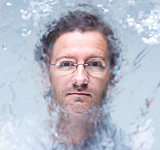 Olafur Eliasson's Waterfalls Spectacle
Olafur Eliasson's Waterfalls Spectacle

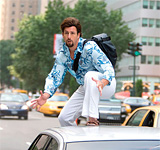 Edelstein on You Don’t Mess With the Zohan
Edelstein on You Don’t Mess With the Zohan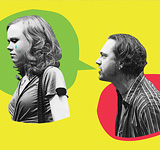 Would Half As Much Neil LaBute Be Twice As Good?
Would Half As Much Neil LaBute Be Twice As Good? The Pre-Summer Guide: Cool Duds, Eats, and More
The Pre-Summer Guide: Cool Duds, Eats, and More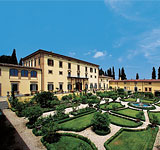 How to Buy a European Castle
How to Buy a European Castle
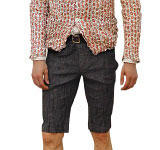 The Best Shorts for Men and Women
The Best Shorts for Men and Women Do These New Spots Redefine Brooklyn Pizza?
Do These New Spots Redefine Brooklyn Pizza?
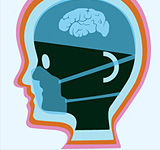 New York’s Best Doctors in Every Field
New York’s Best Doctors in Every Field

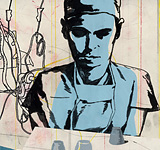 Demystifing the Ethics of Modern-Day Medicine
Demystifing the Ethics of Modern-Day Medicine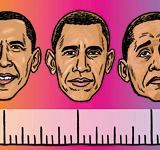 Ten Reasons to Worry About Obama’s Chances
Ten Reasons to Worry About Obama’s Chances